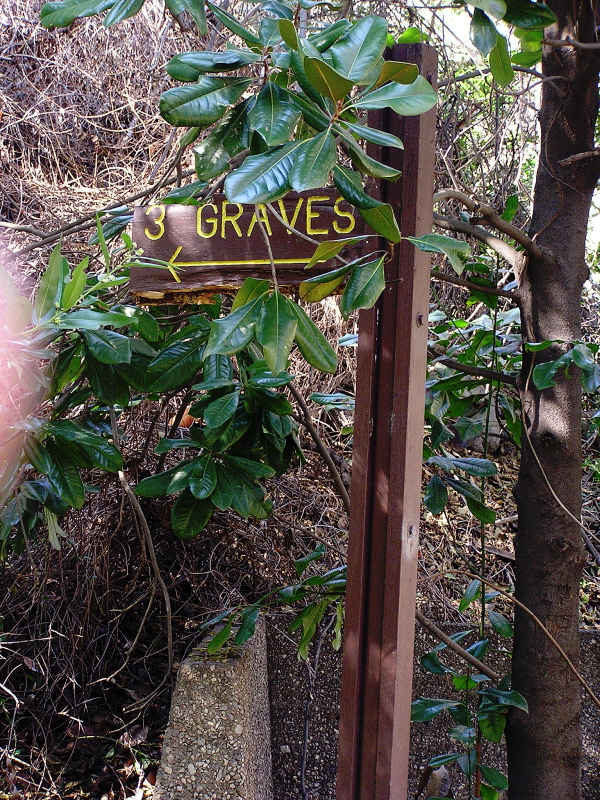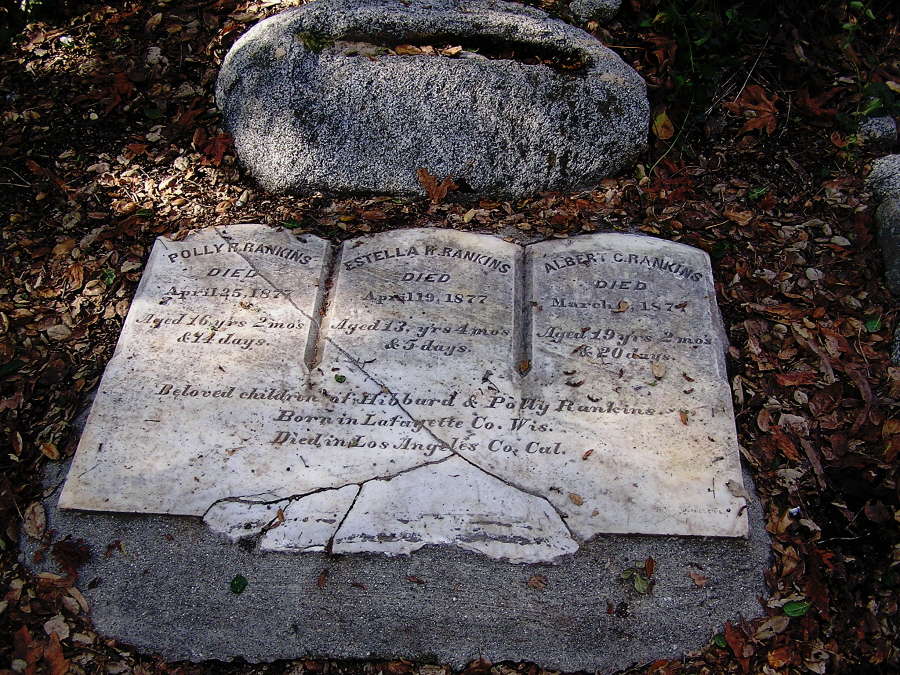
|Home |Park Trails Map |Grave Stones |History |Park Entrance |Overlook Trail |Sawpit Road |Cabin |Self-Guided Nature Trail |Nature Center |Falls Trail Junction |Monrovia Falls |Wildlife |Plantlife |

Signpost at Emerson's Flat Picnic Area marking the short trail leading to the Rankins children's gravesite.

|
|Top of Page |Home |Park Trails Map |History |Park Entrance |Overlook Trail |Sawpit Road |Cabin |Self-Guided Nature Trail |Nature Center |Falls Trail Junction |Monrovia Falls |Wildlife |Plantlife |
The Gravesite of the three Rankins children who died of Typhoid Fever in 1877.
Originally, this triple-gravestone rested in the slot in the granite stone
seen above the gravestone. The bodies of the three children are no longer interred at this site.
Click here for the tragic history of the Rankins Family

|
|Top of Page |Home |Park Trails Map |Grave Stones |Park Entrance |Overlook Trail |Sawpit Road |Cabin |Self-Guided Nature Trail |Nature Center |Falls Trail Junction |Monrovia Falls |Wildlife |Plantlife |
|
About one mile from Monrovia is Sawpit Canyon, a pleasure resort for hundreds of picnickers who make daily and weekly pilgrimages to Sawpit Falls. A few hundred yards from the forks is a large open space, which has the appearance of a well kept lawn. Here are seen two large oaks, a flowering oleander and an orange tree of some year's growth. Under one of these trees is a pile of rocks which appears to have been the foundation of a house. The clue to these traces of early habitation is found in a trail that leads up to a bit of a mesa. On this little eminence are three graves Little is known beyond the fact that the stones record the names of three children who died in 1877. Monrovia did not then exist as a town, but one of the old settlers of Duarte tells this story... Hibbard Rankin, a sturdy former of LaFayette County, in Wisconsin, with his wife Polly and five little children, came to the new world of California and settled in Sawpit Canyon. In a clearing made by an earlier and more adventurous settler he made his home. Under each of the oaks stood a cabin rudely constructed of forest lumber. Fruit trees were set out, a garden was planted, bees helped to furnish a living and the canyon bounty yielded the wood which was hauled with great difficulty to Los Angeles. The father and mother were spirtualist of a type not uncommon at that time, and the oldest daughter was a would-be medium. There were many gatherings of the elect in the interests of the cult in this favorable place. Some of the children attended school in Duarte, walking the entire distance each day. Albert, the nineteen-year-old son, who was a blacksmith's apprentice in San Gabriel, came home for a Sunday visit and suddenly became very ill. The malady proved to be typhoid fever. There were few facilities for nursing, the only doctor being a young man who was far gone with consumption. Imagine the sorrow of the family when, in a few weeks time, nineteen-year-old Albert, thirteen-year-old Polly and sixteen-year-old Stella were laid to rest in this improvised graveyard. The place soon became too lonely for the bereaved parents and they returned to their home in Wisconsin. A canyon fire swept the cabin from the place and the flood of 1882 displaced the foundation. The only reminder of that mountain home and its sorrow is the small graveyard. from "The Crimson and White" by Stella Nelson, Monrovia High School - Class of 1913 |
|
The pioneer settlers of Monrovia Canyon were Hibbard Rankins, his wife Polly and their four children, who arrived in 1874. The Rankins family, having journeyed
from Wisconsin to California, built a little cabin in the lower canyon, planted vegetables and fruit orchard, and cut wood in the old sawpit after which
Sawpit Canyon is named. It was this latter enterprise that provided the close-knit fmily with its main livelihood. They hauled the wood to Los Angeles and
sold it there, the round trip by wagon taking two days. They kept bees and sold honey as an additional source of income. The Rankins children attended school
in Duarte and walked the entire distance from their canyon home to school and back every day, remembered a Duarte oldtimer. Tragedy - one of the saddest episodes in the long saga of the San Gabriel Mountains - struck the Rankins family in 1877. The oldest child, Albert, age 19, was apprenticed to a blacksmith in San Gabriel and somehow he contracted typhoid fever. He died after a short illness on March 6. While the family was still mourning, both girls, Estella, age 13, and Polly, age 16, came down with the dreaded disease. They died within a week of each other, on April 19 and 25. Heartbroken, their lives shattered, Mr. and Mrs. Rankins buried their three children on a little rise above their cabin and marked the grave with a triple tombstone that included the children's names, ages and dates of death engraved in marble. The bereaved parents and their sole surviving child, Ernest, then returned to Wisconsin. Years later, Ernest Rankins returned to the scene of his family's tragedy and removed his brother and sister's remains to a cemetery in Monrovia. Still later, they were again removed and taken to their final resting place, Mountain View Cemetery in Altadena. from "The San Gabriels" by John W. Robinson, p. 32 |
|Top of Page |Home |Park Trails Map |Grave Stones |History |Park Entrance |Overlook Trail |Sawpit Road |Cabin |Self-Guided Nature Trail |Nature Center |Falls Trail Junction |Monrovia Falls |Wildlife |Plantlife |
URL for this page: http://hikertechnologies.com/mcp_rankins_graves.htm
This page developed by Bob Dollins © 2002-2022 - All Rights Reserved
GIF Art - Copyright © 1995-1998 IDG Books Worldwide, Inc.
Version (01.15): December 1, 2021